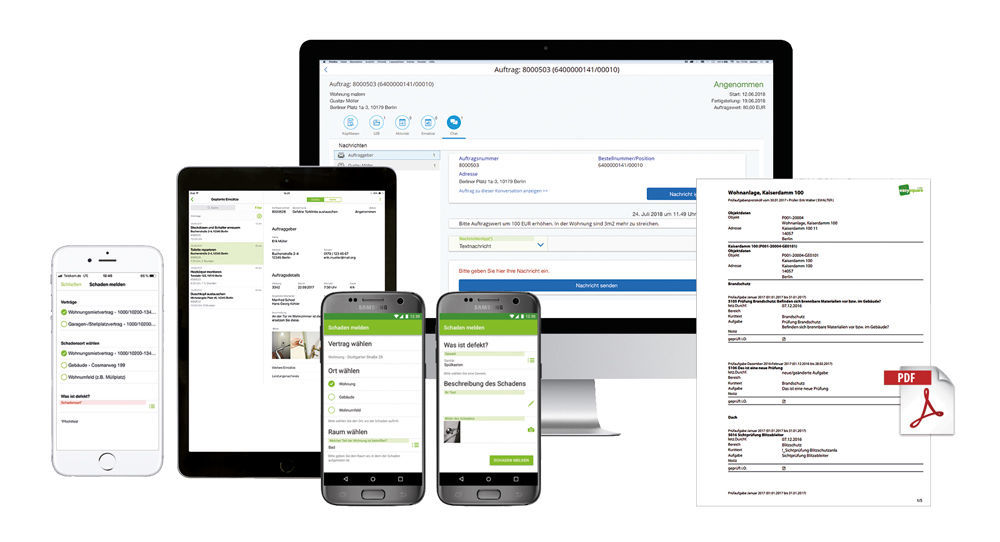Digital forms – Why paper forms are a thing of the past
We find them everywhere. Be it when returning keys to the landlord or when acknowledging the electrician, practically all companies use predefined forms or check lists for the areas of service or maintenance. In the worst case scenario, they are still in paper form. Using the latter leads to media discontinuity because most companies already use ERP systems, into which the information ultimately needs to be transferred. So why not go digital right away?
There are good reasons why digital forms are greatly superior to their equivalent in paper format.
No media discontinuity
To begin with, digital forms avoid the errors that may arise when paper forms are manually transferred to the ERP system. Is the writing illegible, has someone got the digits of a number the wrong way round or can the paper no longer be found? Recording the data digitally on site reduces the potential for error and facilitates the task of data entry – be it by documenting the data with photos or selecting predefined catalogues. It makes no difference here whether it is done online or offline.
Higher data quality
At the same time, there is an increase in both the quality and the quantity of your data. Distinguishing between mandatory and optional form fields ensures that all the necessary data, or the data that is required by law or contract for certain work processes, is recorded. The high-quality data gained is rounded off by audit-proof documentation in the central ERP system. Your data pool then provides an excellent basis for forward-looking planning and measures.
Time gains
Firstly, there is no need to spend hours cumbersomely transferring piles of paper forms to your ERP system. Secondly, the digital forms receive the data directly from the business process, meaning that a great deal of information can be transferred to the form automatically. A few examples here include the name of the processor, the order details and the customer’s address. These don’t need to be entered again each time, but rather are automatically entered in the form right from the start. Moreover, the fact that the fields can be dynamically adapted for each entry ensures that the data is complete, makes things easier for the person entering the data and thus speeds up processing.
Maximum flexibility
Digital forms provide companies with infinite possibilities and offer maximum flexibility. If the forms need to be adapted throughout the company, for example, the updates can be rolled out centrally. In this way you can ensure that the right template is used at all times. There is no longer any need to dispose of form blocks that are no longer needed – something that is beneficial not only for the budget, but also for the environment.
There is a broad range of digital forms and check lists:
- Recording various fixtures and fittings of apartments or technical objects
- Check lists for verifying safety precaution obligations or similar inspections
- Functional tests for technical systems
- Maintenance lists
- Handover logs
- Calculations during renovation, for instance for vacant apartments
- Reports in various forms, for instance regarding damage or updating bank details
- Requests and orders in various forms, for instance to tradesmen or suppliers
- Surveys, for example among tenants or in the neighbourhood
- Time accounting
- Service entry for external service providers
- Applications, for example from potential tenants
- Releases and approvals
The process is the trump card
Behind every form there is a process that needs to be digitised. One crucial advantage compared to paper forms is that digital forms can trigger follow-on processes in the company completely automatically. The best example here is when a tenant reports defects. This report gives rise to an entire processing chain, from receiving the report, finding a processor and checking it through to commissioning external service providers and finally billing the services provided. This may also be supplemented by an insurance claim and we now have a process that can be completely automated. However, the process was initiated by the tenant, meaning that one work step has been entirely outsourced from the company. All the necessary data may be displayed, for example, by a tenant app on a digital form that the tenant completes.
Thanks to all these reasons, there is a significant decrease in the administrative effort involved in your service and maintenance processes. Efficiency increases, while costs decrease.

Be it in a tenant app, on the craftsmen portal or in the form of an archived document in the ERP system, there are a wide range of possible uses for easysquare digital forms. In today's professional world, it is vital that they can be used device-independently.
Do you have an application case that we have not already mentioned? Then write to us! We will find a suitable solution for any scenario.
You may also be interested in the following topics:
- Control and link up mobile processes by using easysquare mobile
- Control processes intelligently and easily by using easysquare workflow
- Study: Savings potential in mobile property inspection with easysquare mobile adds up to more than 50 percent
- Success Story "iPad replaces deluge of forms"
- Success Story "How the iPad is literally lightening the load for Vonovia’s property managers"
- Interview “The cloud solution is just the start of our digitisation strategy”

